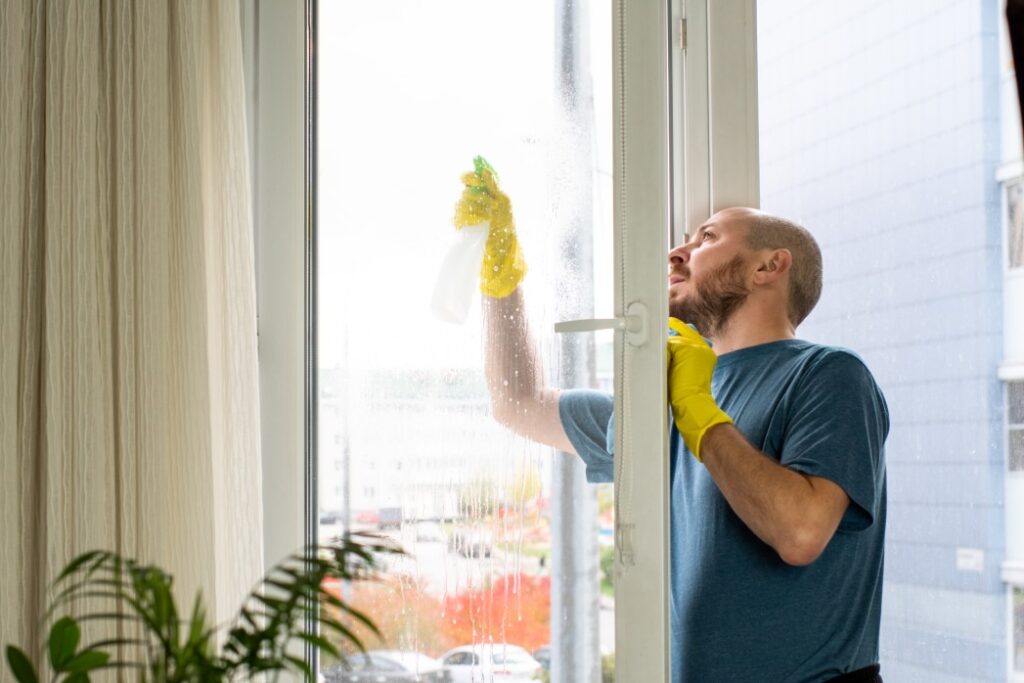Colleyville Window Cleaning Service unique challenges due to the height and accessibility issues.

However, with careful planning, the right equipment, and safety measures, you can achieve sparkling, clear windows even in the highest reaches of a skyscraper. In this comprehensive guide, we’ll explore the best ways to clean windows in a high-rise building, ensuring both efficiency and safety.
1. Safety First: Before delving into the cleaning process, prioritize safety. High-rise window cleaning involves working at heights, and safety should be the top priority. Ensure compliance with local safety regulations, and if needed, hire professional window cleaning services with expertise in high-rise buildings.
2. Assess the Building Structure: Before starting the cleaning process, thoroughly assess the structure of the high-rise building. Take note of any architectural features, setbacks, or obstacles that may affect the window cleaning process. This information will help you plan the most efficient approach.
3. Obtain Necessary Permits: Depending on the location and building regulations, you may need permits or approvals to conduct high-rise window cleaning. Check with local authorities to ensure compliance with safety and environmental standards.
4. Choose the Right Equipment: Invest in high-quality and industry-approved window cleaning equipment suitable for high-rise buildings. This may include telescopic poles, water-fed brushes, safety harnesses, and a reliable suspension system if working from a platform or bosun’s chair.
5. Water-Fed Pole System: Consider using a water-fed pole system, which allows for cleaning windows at heights without the need for ladders or scaffolding. These poles are equipped with brushes and water jets, providing a thorough clean while ensuring the safety of the operator.
6. Rope Access Technique: Rope access is a commonly used technique for high-rise window cleaning. Certified technicians use industrial ropes and harnesses to access and clean windows from the exterior of the building. This method is efficient and widely used in skyscraper maintenance.
7. Boom Lifts or Cherry Pickers: In some cases, especially for windows that are difficult to reach, boom lifts or cherry pickers may be employed. These hydraulic platforms provide a stable and elevated work platform for window cleaners to access high windows.
8. Exterior Building Maintenance Units (BMUs): Some high-rise buildings are equipped with exterior Building Maintenance Units (BMUs) or window-washing gondolas. These motorized systems allow window cleaners to move horizontally and vertically along the building facade, reaching windows at various heights.
9. Coordinate with Building Management: Work closely with building management to coordinate window cleaning schedules. They can provide valuable information about building access points, safety protocols, and any specific requirements for window cleaning.
10. Weather Considerations: Be mindful of weather conditions when scheduling high-rise window cleaning. Strong winds, rain, or extreme temperatures can impact the safety and effectiveness of the cleaning process. Plan for optimal weather conditions to ensure a successful operation.
11. Use Professional Cleaning Solutions: Choose professional-grade window cleaning solutions suitable for high-rise buildings. These solutions are formulated to provide effective cleaning without leaving streaks or residue on the windows.
12. Implement a Water Purification System: If using a water-fed pole system, consider implementing a water purification system. Purified water reduces the likelihood of streaks or water spots on the windows, leaving a pristine finish.
13. Focus on Safety Training: If you have an in-house window cleaning team, prioritize safety training. Ensure that all team members are well-trained in using safety equipment, harnesses, and following proper procedures for high-rise window cleaning.
14. Plan for Regular Maintenance: Establish a regular window cleaning schedule to prevent the buildup of dirt and grime on high-rise windows. Regular maintenance ensures that windows remain clean and clear, enhancing the building’s aesthetics.
15. Consider Environmental Impact: Choose cleaning solutions that have minimal environmental impact. Some high-rise buildings may have specific requirements for environmentally friendly cleaning products.
16. Interior Window Cleaning: While the focus is often on exterior windows, don’t neglect interior window cleaning. Work with building management to coordinate access to interior spaces for thorough cleaning.
17. Use Microfiber Cloths for Detailing: For a finishing touch, use microfiber cloths for detailing. These cloths are effective in removing any remaining streaks or water spots, leaving the windows crystal clear.
18. Post-Cleaning Inspection: After completing the window cleaning process, conduct a thorough inspection to ensure that all windows are clean and free of streaks or spots. Address any areas that may need additional attention.
19. Document and Report Issues: Document any issues or concerns observed during the cleaning process and report them to building management. This collaborative approach helps address maintenance issues promptly.
20. Professional Window Cleaning Services: For complex high-rise window cleaning tasks, consider hiring professional window cleaning services with experience in working on tall buildings. They have the expertise, equipment, and safety measures in place for efficient and safe window cleaning.
21. Evaluate New Technologies: Stay informed about new technologies in high-rise window cleaning. Advancements in robotics and drone technology are being explored for window cleaning applications in some high-rise buildings.
22. Consult Experts for Unusual Architectural Features: If the high-rise building has unusual architectural features or challenging design elements, consult with experts in high-rise window cleaning. They can provide insights and solutions tailored to the building’s specific requirements.
23. Celebrate Success: Once the high-rise window cleaning is successfully completed, take a moment to celebrate the success. Enjoy the improved aesthetics and clarity that clean windows bring to the building.
In conclusion, Colleyville Window Cleaning Service requires a strategic and safety-focused approach. By employing the right equipment, techniques, and safety measures, you can achieve impeccable windows that enhance the overall appearance of the skyscraper. Whether using water-fed poles, rope access, or other methods, prioritizing safety and efficiency is key to a successful high-rise window cleaning operation.
DFW Window Cleaning Colleyville
1808 Maplewood Trail, Colleyville, TX 76034, United States
1-817-813-8010









